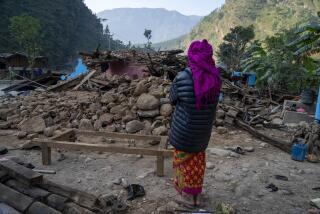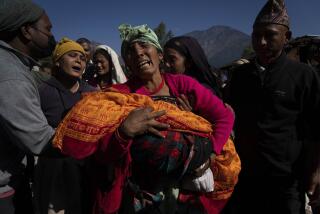20,000 Feared Dead as Quake Devastates Historic Iranian City
- Share via
TEHRAN — Iranian officials said today that an estimated 20,000 people were killed and tens of thousands were injured Friday when an earthquake leveled much of the historic city of Bam.
The quake flattened more than half and perhaps up to three-quarters of the buildings in Bam, known for a giant ancient fortress complete with towers and domes made of mud brick. About 600 miles southeast Tehran, Bam, with a population of 80,000, is the heart of a region with about a quarter of a million people.
The Interior Ministry said that an accurate count was impossible with many victims buried in rubble but that the preliminary toll was 20,000 dead.
Most of the injured were left without shelter during a night of temperatures in the 20s.
Even for Iran, where deadly earthquakes are not uncommon, the devastation was large.
“The disaster is far too huge for us to meet all of our needs,” President Mohammad Khatami said. “However, all the institutions have been mobilized.”
Speaking on television, Khatami called for international assistance, and the world responded. Russia, Europe and the United Nations immediately pledged food, blankets and volunteers to the recovery effort.
The United States and Iran have not had diplomatic relations since the 1979 Islamic Revolution. President Bush has called Iran part of an “axis of evil” and has accused it of attempting to secretly develop nuclear weapons.
Despite those tensions, Bush issued a sympathetic statement from his ranch near Crawford, Texas.
“Laura and I heard this morning of the earthquake centered in the city of Bam, Iran,” the statement said. “We are greatly saddened by the loss of life, injuries and widespread damage to this ancient city. I extend my condolences to all those touched by this tragedy. The thoughts of all Americans are with the victims and their families at this time, and we stand ready to help the people of Iran.”
IRNA, the state news agency, put the quake’s magnitude at 6.3; the U.S. Geological Survey said it was 6.5. The earthquake ripped through Bam around 5.30 a.m., when most of the city’s residents were sleeping. Marked by flimsy construction and clusters of mud-brick homes, the city was particularly vulnerable.
The city’s citadel, one of the largest mud-brick buildings in the world, was heavily damaged. With its intricately wrinkled walls and remains of mosques and shops, the fortress, parts of which date to the 16th century or earlier, is one of Iran’s biggest tourist draws.
“The site of Bam is considered one of the very, very important sites of mud-brick architecture,” said Mounir Bouchenaki, a United Nations heritage specialist. The U.N. cultural agency asked Iran to send a team of experts to the fortress.
“The entire town will need to be rebuilt,” Bam governor Ali Shafii told state television. “You look everywhere, you will see piles of rubble and ... many of the bodies are still under the rubble. People are suffering from cold, and there is an immediate need for tents, medicines, food.”
Khatami called the earthquake “a national tragedy.”
As a long afternoon turned to night, rescue crews fought the cold, darkness and bitter desert winds to hunt for thousands of people still missing. Telephone service, electricity and water lines were destroyed. Aftershocks rattled the land, and television showed images of homeless survivors building bonfires in the streets to ward off the cold. At the city’s only cemetery, bulldozers dug a mass grave.
“This is the apocalypse. There is nothing but devastation and debris,” Mohammed Karimi told an Associated Press photographer. Tears streamed down his face; he had brought the bodies of his wife and 4-year-old daughter to be buried.
Pictures on Iranian television showed men rooting in the debris with bare hands, guided only by firelight. Finally, they pulled from the rubble a young man who stared around with haunted eyes while they draped a blanket over his shoulders. Tearful children dug for their parents.
Two of Bam’s hospitals reportedly collapsed, killing most of the staff. The rest of the hospitals overflowed with patients huddled in blankets.
The roads out of town were choked with ambulances carrying the wounded to the nearby city of Kerman. Others among the injured were taken by military planes.
Officials took to the airwaves to plead for blood, disinfectant, blankets, bulldozers and dogs to help sniff out people still trapped in the debris. “There are a lot of dead and injured in Bam city, and everything is being done to take them out,” said Mohammed Ali Karimi, governor of Kerman province.
Dozens of corpses covered in white dust lay alongside the pulverized remains of houses. In the streets, women swathed in black chadors pummeled their chests in grief, and men beat their heads. Some tottered through the ruins in a daze.
“I have lost all my family,” said Maryam, a 17-year-old girl. “My parents, my grandmother and two sisters are under the rubble.”
Three days of national mourning were declared across the Muslim nation.
In Tehran, thousands rushed to give blood. Donation drives for food and clothing were quickly organized.
Hundreds of rescue workers poured into Bam and search dogs were brought from across the country to join the hunt for survivors.
“That will not be enough,” said an Iranian Red Crescent official, Musatafa Mogaghegh. “We need help from the international community.”
Russian airplanes loaded with 100 search experts, 10 doctors and search dogs were to take off for Iran early today. Italy sent a military transport plane with a sniffer dog unit, fire brigades and search teams. France sent a field hospital. Turkey sent search-and-rescue workers, tents, blankets and medicine. Jordan was loading a plane with tents, medicine and food. The Czech Republic offered aid, as did Germany, Spain and Belgium.
Rescue teams from the United Nations, the International Committee of the Red Cross and Britain also were on their way to Bam late Friday. The city’s small airport was opened up to receive the international flights.
Several major fault lines cross Iran, making disastrous earthquakes relatively common. In June 2002, a magnitude 6.3 quake struck northern Iran. More than 200 people died, and 1,300 were injured. One of the most devastating earthquakes in recent history, a magnitude 7.7 temblor, hit northwest Iran in 1990, killing more than 40,000 people.
“We can restore the citadel,” said architect Shahriar Ghadimi. “It’s the loss of human lives that we cannot restore.”
Special correspondent Anvari reported from Tehran and special correspondent Zaman from Istanbul, Turkey. Times staff writer Edwin Chen in Crawford and special correspondent Lily Sadeghi in Tehran contributed to this report.
*
(BEGIN TEXT OF INFOBOX)
Major earthquakes in recent years
Dec. 12, 1992: Indonesia. A magnitude 6.8 quake killed at least 2,200 people on a string of islands in the province of East Nusa Tenggara.
Sept. 30, 1993: India. A series of quakes killed more than 20,000 people in western and southern India. The first tremor measured a magnitude of 6.4.
Jan. 17, 1995: Japan. A magnitude 7.2 quake rocked Kobe, killing nearly 6,500 people.
May 28, 1995: Russia. A magnitude 7.5 quake killed nearly 2,000 people in the oil-producing Far East.
May 10, 1997: Iran. A magnitude 7.1 quake killed at least 2,400 people in eastern Iran near the Afghan border.
Feb. 4, 1998: Afghanistan. A magnitude 6.1 quake killed at least 4,500 people in the north.
May 30, 1998: Afghanistan. A magnitude 6.9 quake killed as many as 5,000 people in northern Afghanistan.
July 17, 1998: Papua New Guinea. An undersea quake measuring a magnitude of 7.1 created tidal waves that killed 3,000 people.
Jan. 25, 1999: Colombia. A magnitude 6 quake killed nearly 1,000 people in the central coffee-growing region.
Aug. 17, 1999: Turkey. A magnitude 7.4 quake left more than 17,000 people dead.
Sept. 21, 1999: Taiwan. A magnitude 7.6 quake killed about 2,400 people.
Nov. 12, 1999: Turkey. A magnitude 7.2 quake in the northwest killed at least 700 people.
Jan. 26, 2001: India. A magnitude 7.7 quake in the western state of Gujarat killed at least 19,700 people.
March 25, 2002: Afghanistan. At least 1,500 people were killed when a series of earthquakes, measuring between magnitude 5 and 6, struck northern Afghanistan.
May 21, 2003: Algeria. A magnitude 6.7 quake killed more than 2,200 people.
Dec. 26, 2003: Iran. A magnitude 6.3 quake in the city of Bam killed at least 5,000 people.
Source: Reuters
Los Angeles Times
More to Read
Sign up for Essential California
The most important California stories and recommendations in your inbox every morning.
You may occasionally receive promotional content from the Los Angeles Times.










